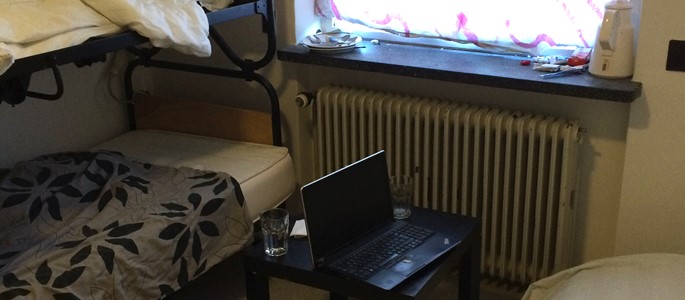Social Harm in the Danish Asylum System
Researcher: Structural conditions and practices are harming people seeking asylum in Denmark
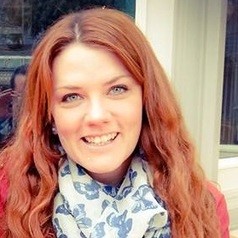
Dr. Victoria Canning has a PhD in Criminology, she is a lecturer at Bristol University and a ESRC Research Fellow at The Open University, London. Her book 'Gendered Harm and Structural Violence in the British Asylum System' (2018) received the British Society of Criminology Book Prize.
Irlin Osaland has a MSc in Global Development and a BA in Social Anthropology. She made the interview with Canning as an intern at REFUGEES.DK
A new research project conducted and lead by Dr Victoria Canning (Associate Professor in Criminology at the University of Bristol) examines harmful practices in the Danish asylum system. In her forthcoming report, she demonstrates how Danish policies are having significant impact on the wellbeing of people seeking asylum (particularly women and survivors of violence), and examines a number of problematic practices in what she calls ‘an architecture of exclusion’.
Denmark has undergone a significant ideological shift in its approach to migration and asylum. As a country that used to be characterised as comparatively welcoming for refugees and migrants, Denmark is now known for its increasingly restrictive asylum policies and anti-immigration rhetoric. Since 2015 alone, Denmark has adopted some 98 amendments, further tightening immigration laws. Through harsh structural conditions and practices, the current Venstre-led government have made no secret of their effort to reduce, remove and deter people seeking asylum. The threat or reality of deportation is part of the everyday experience, and within this hostile system, the aim has become to make life ‘intolerable’ for rejected asylum seekers, according to Inger Støjberg, the Minister of Immigration, Integration and Housing.
The structural conditions and practices are harming people in the asylum system, whether they are in the process of getting a ruling on their asylum claim, have gained asylum or have had their application denied. A recent report by Global Detention Project raised serious concerns about the direction Denmark is taking. Key concerns included inadequate procedures for identifying torture survivors; increasingly ‘prison-like’ asylum centres; detention practices; lack of statistics and data on detained asylum seekers; grounds for detention; and time in detention and isolation.
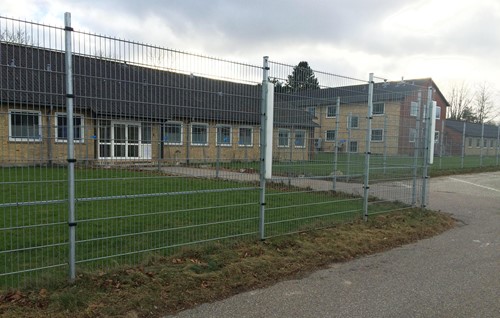
Udrejsecenter Sjælsmark, internt hegn
‘Det utålelige liv'
Canning har forsket i asylsystemer i Storbritannien i over ti år, og i Danmark og Sverige fra 2013. Hun har interviewet både asylansøgere, medarbejdere på centrene og NGO'er til sin rapport. Hun hævder, at Danmark bevæger sig væk fra at være forankret i socialdemokratisk tankegang til i stigende grad at spejle sig i en af sine mindre liberale sydlige naboer, Storbritannien:
"Da jeg begyndte at forske i asylsystemet i Danmark i 2013, talte jeg med folk om de sociale skadevirkninger i det britiske asylsystem, og de svarede "Det ville aldrig kunne ske her i Danmark! " Når jeg taler med folk nu, siger de: ”Åh ja, det gør vi hele tiden i Danmark”. Skiftet hen imod ekskluderende og straffende politik har været og er utroligt bekymrende " – Canning
Canning hævder, at den danske stat bevæger sig hen imod en britisk asylpolitik og tilhørende praksisser, og derved skaber et skadeligt miljø for folk, der søger asyl. Gennem statslig påtvunget afhængighed, udelukkelse og banale, men ikke desto mindre skadelige, daglige praksisser presser den danske stat succesfuldt grænserne med det formål at få asylansøgere til at forlade landet. Det skader integrationen og påvirker menneskers trivsel negativt:
"Danmark er ret unikt i sin åbenlyse indsats for at ekskludere og dehumanisere. Mens de samme konsekvenser opstår for asylansøgere i Sverige og Storbritannien, såsom armod og isolation, har Danmark udtrykkeligt skrevet dem ind i sin asylarkitektur i form af hjemrejse- og udrejsecentre. Gennem hverdagens praksisser og reduktion af autonomi, lige fra dårlige fødevarestandarder til manglende meningsfulde aktiviteter, er systemet designet til at skabe en følelse af afvisning, for at motivere folk til at forlade landet. Det faktum, der står tilbage, er at deres sikkerhed ikke kan garanteres andre steder, hvis og når de vælger at forlade landet”. – Canning
Cannings forskning viser, hvordan eksklusion og dehumanisering bliver synlig gennem praksisser af sociale skadevirkninger: Udelukkelse og isolation samt tab af autonomi og uvished omkring fremtiden. Hun understreger yderligere kønsmæssige implikationer for kvinder i asylsystemet.
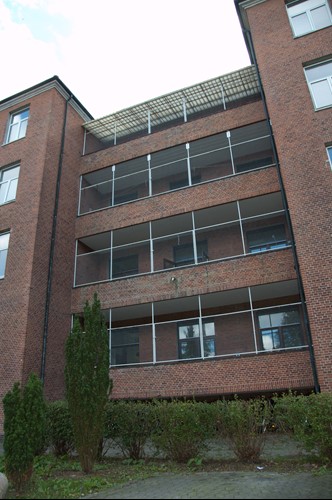
Asylcenter Avnstrup, med gitre for svalegangene
En ekskluderende arkitektur
Although, in most centres, asylum seekers can come and go as they like, there is a political will directed at keeping asylum seekers at a distance, socially disconnected from the rest of society (Whyte, 2011). When we talk about the architecture of exclusion, we are talking about spatial harm created through physical barriers such as fences and access control, to the infrastructural decisions about where the asylum centres are located. We should be questioning the architecture of asylum centres in Denmark, many of which resemble ‘prison-like’ institutions more than a place for vulnerable persons asking protection. Why are there fences and gates around a place such as Sandholm, where asylum seekers have the right to move freely? Allegedly “for the asylum seekers’ protection”.
Since 2017, asylum centres in Denmark are increasingly located on peripheries in Jutland, away from towns and cities, in buildings that used to be former military barracks, training camps or sanatoriums. Even though most asylum seekers are able to come and go as they like on paper, few have the resources or ability to do so. Their freedom of movement is in fact limited, because residents have no right to work and most often receive no cash allowances, and therefore lack resources to travel with public transportation (if there is any), to the nearest town or city. As one of Canning’s participants confirms:
'The key is to cut off people’s access to networks, to anything that may make them want to stay. And I guess access to certain social services is also part of that package, because it’s the investment of the welfare state.' - cites from interviews with staff from Sjælsmark in Canning’s forthcoming report.
Exclusion and isolation also has gendered implications. School hours restrict parents’ movements, and single mothers in particular are less able to undertake language classes or spend time with other people. During Canning’s fieldwork in these centres, she found that women in particular were not able to leave the centres due to childcare responsibilities. This deliberate practice of isolating asylum seekers from the rest of society could be seen as a form of existential confinement. It limits access to relationships and support networks outside of the centres, access to legal advice, and in general, access to activities outside of the centres.
The decision to place asylum seekers in the middle of nowhere puts added strain on organisations supporting asylum seekers, as access is made more difficult. Most NGOs working with this particular group of people are Copenhagen based, meaning that access to legal and psychological support is reduced. This is incredibly worrying, as many has suffered and gone through various trauma before arriving to Denmark, and should have access to both legal and psychological support.
The architecture of exclusion works to contain and exclude bodies from the rest of society. This in turn, works against the efforts made by the government on integration, if and when an asylum seeker obtains residency. In addition to the spatial harm inflicted upon people seeking asylum, is the temporal harm of long and uncertain waiting times.
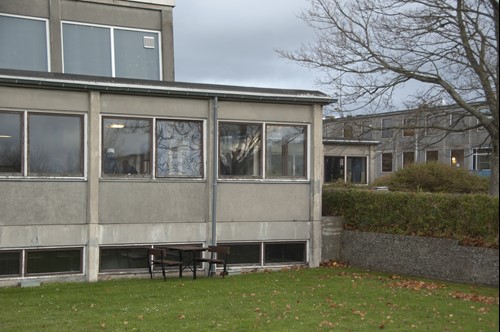
Asylum center Auderød, now shut down
Temporal Harm
For people seeking asylum, temporality is often conceptualized as waiting, existing somewhere in-between, and it has been widely documented by practitioners and researchers how temporal uncertainty harms individuals and their quality of life. Years of someone’s life can go by in the system without knowing if and when they will be granted asylum, or if they’ll be detained and/or deported, which impacts a person’s physical and mental state strongly.
The waiting time for a person seeking asylum varies, depending on the overall pressure on the system and the individual case. That makes it difficult to specify waiting time for cases in general. According to nyidanmark, the average waiting time for deciding on an asylum case, is 7 months. A case following the Manifestly Unfounded or Manifestly Wellfounded procedure can be finished in less than three months, whereas a case in the Normal Procedure going all the way through second instance can take up to two years (refugees.dk). After a final rejection, the person can end up living in the system for many years – waiting for reopening the case and/or attempts at deportation, which may be futile.
Moreover, the Danish government has also introduced a line of new restrictions making it increasingly difficult and uncertain for individuals who are granted asylum. Compared to previously, where asylum would be granted for 5-7 years and almost automatically extended, today it has been reduced to 1-2 years, and extension is not always granted. Regardless of whether you receive refugee status, protection status or temporary protection status, the government does not give out residence permits that exceed two years, before you have to reapply. This means that even for those who have had their asylum claims recognized by the state, they still face uncertainty about their future in Denmark. Permanent stay can only be applied for after 8 years, and the demands are too high for most refugees to meet.
These are harmful policies, because they add further temporal harm, and limit people’s ability to integrate into society.
Imagine spending years in the asylum system, not knowing what your future holds? Some are rejected and get stuck in the asylum centres, others are granted asylum but not given the right to remain permanently. These policies and practices do not welcome people to integrate into the society, but instead increase feelings of isolation, fear and even suicidality.
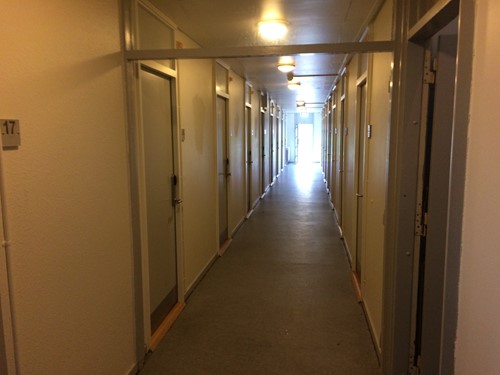
Hallway with rooms, deportation camp Kærshovedgård
Loss of Autonomy
Denmark removes asylum seekers’ own autonomy through isolation, dependency and other banal everyday practices. Once in the system, asylum seekers can do very little while they wait for their application to be processed. You must live in the centres, completely dependent on the system. Single men and women often share a room with 2-4 others, and have to share a common bathroom with up to 30 people, which limits their access to privacy. The absence and/or possibility of engaging in productive activities and access social networks, undoubtedly effect a person’s self worth, dignity, identity and wellbeing.
In theory, asylum seekers in phase 2 (waiting for the application to be processed) are allowed to work after being in the asylum system for six months. However, bureaucratic and spatial challenges make it nearly impossible. Very few are able to find a job, let alone get it approved as asylum seekers lack access to CPR number and a bank account, which is required by most employers. Beyond this, there’s the spatial challenges of accessing societies as most asylum centres are located in the middle of nowhere. Hence, most asylum seekers find themselves dependent on pocket-money and/or basic needs from the state, waiting in limbo while their case is being processed. One staff member at Sjælsmark explained to Canning, that the limited access to activities and networks, works to prevent a person from wanting to stay, if and when their claim is denied:
'If they have something to look forward to next month, they may not be motivated as much to leave’' – Cites from interviews with Sjælsmark staff in Canning’s forthcoming report.
The situation worsens if an asylum seeker is in phase 3 (application has been denied), and moved to one of the departure centres (Avnstrup, Sjælsmark or Kærshovedgård). At these centres, asylum seekers do not receive pocket-money, are not allowed to work, face the risk of imprisonment in Ellebæk and/or deportation, and have to attend weekly meetings with the police. They live in constant uncertainty about their future, with limited resources to buy their own food and other essentials, or even be able to buy a bus ticket. Instead, there is a cafeteria in the centres, providing three meals a day, each meal served for only 45 minutes. One cannot ask for specific food choices based on health or religious reasons, and residents are not allowed to have food in their rooms. This is another practice limiting asylum seekers own autonomy on an everyday basis: You have to be at the centre at specific times to receive basic needs, such as food, and you are not even allowed to decide what to eat. The practice of making the asylum seeker completely dependent on the state reduces the person to a ‘child-like’ person, someone that does not have autonomy over their own life.
Inactivity and lack of autonomy negatively impacts a human being, and can cause depression, anxiety and PTSD.
Living in limbo, without access to productive activities and without support from networks and family, add further distress, deprivation and mental and physical problems. People are getting sick from being in the asylum system. Further, and importantly, if an asylum seeker is granted asylum, the harsh experience from the system can negatively impact their ability to integrate into the Danish society.

The canteen at deportation camp Kærshovedgård
Women in a system designed for men
Another worrying observation made by Canning is that the Danish asylum system is designed for men, despite the fact that women make up 30% of all asylum seekers. She argues that Danish policies and practices ignore the experiences, vulnerabilities, sufferings and needs which predominantly pertains to women and other minority groups.
'There is a serious lack of consciousness around women's experiences of asylum. From my research, it is clear that many are cut off from society through poverty, and unable to travel from asylum or departure centres if they have children in school. Psychological support is difficult or impossible to obtain, and survivors of sexual violence or torture face significant barriers to gaining support at least until they receive refugee status, and even then it is not easy. Pregnant women are still being detained, and women-only spaces are almost non-existent in camps. It's incredibly worrying from a women's rights perspective' – Canning
As social and psychological support continue to be reduced, many are left in an unsupported limbo, and women survivors of violence in particular, at the periphery of society. Beyond the lack of access to psychological support, women are also feeling unsafe, living in centres with a majority of men. The asylum system lacks proper safe spaces for women. Why are there not more efforts to create separated areas in asylum centres for women, when we know that they face threats, violence and sexual assault? As Michala Clante Bendixen states in her article on ’Women in an asylum system for men’, there is no rational or economic reasoning for why there are no centres exclusively for women. An answer to this question from Danish Immigration Service shows a total misunderstanding of the concept of gender equality: “Everybody, regardless of race, ethnicity, sexual orientation, religious beliefs etc. should be accommodated in the same asylum centre, as they will later be living together in Danish society if they are granted residence permit.”
Besides the lack of women-only spaces in Danish asylum centres, there is insufficient recognition of gender based asylum motives. Well-founded fear of persecution simply for being female is real, yet too often ignored. Today, most women are granted weaker protection status (§7.3), which only grants asylum for 1 year, without the right to family reunification for the first three years, and without access to higher education. This can be explained in different ways, but the fact remains that women end up in a weaker position than men.
Understanding gender should be essential in implementing policies and practices aimed at protecting women so that they can become active participants in society. When women come from countries where they have been disproportionately denied education and access to the public sphere, why are the criteria the same for them as for men when it comes to asylum procedures?
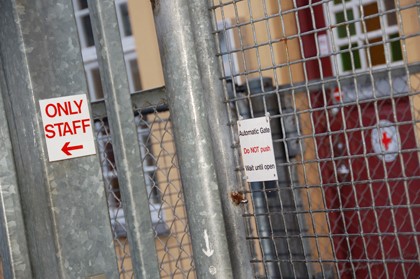
Entrance to asylum center Sandholm
‘Humanitarianism’ in a hostile environment
’I do think that the Red Cross presence to some extent is important because if we weren’t there, there would be absolutely nothing. But at the same time we have to make sure that if we’re there we claim the space that we need to be able to do what we have to do, so that we’re not in a position where we try to provide people certain services and then they’re shut down’ – Sjælsmark staff
Red Cross Denmark runs several of the asylum centres today, and have also agreed to do some work in the much discussed deportation centres Kærshovedgård and Sjælsmark, which are run by The Danish Prison and Probation Service. This is overall a good thing, as Red Cross aims for ‘asylum seekers in Denmark to have a safe, meaningful and worthy life, while waiting for their case to be processed’. There is no doubt that the presence of Red Cross, with their expertise and experience, can positively influence the lived experiences of asylum seekers. However, they seem to have become a silent bystander, instead of speaking up against the inhumane treatment of the very people they seek to protect. The involvement of Red Cross, in particular in places such as Kærshovedgård, plays a role in legitimizing harmful practices through ‘humanitarianism’, because if Red Cross is working there, it can’t be that bad. But can the Red Cross be part of the deportation centres, where the objective is to make ‘life intolerable’, so that they themselves decide to leave Denmark?
’At Shelsmark we’re discussing whether you should be allowed to do anything because it’s supposed to be motivating people to depart’ – Sjælsmark staff
The problem is, that if Red Cross stands up and criticizes the current structural conditions and practices, the government may as well choose to ‘go another direction’, appointing the municipalities, private security companies or the Prison and Probation Service to be in charge of all asylum centres. Not only would Red Cross lose a lot of employees, but they would also lose the influence they have in ensuring that life is somewhat tolerable for people seeking asylum. The situation is proving to be a double-edged sword. If Red Cross openly criticizes the often harmful conditions for people seeking asylum, they could potentially be removed from the system, making life even more ‘intolerable’ for the people they seek to protect. As a result, Red Cross is, despite of their good intentions, to some degree actively participating in preserving a harmful environment, rather than changing it.
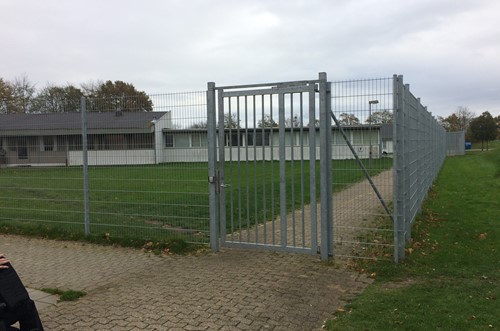
Entrance to the care unit at Kærshovedgård, run by Røde Kors
Concluding thoughts
The government is more concerned with passing policies aimed at containment and isolation, rather than protection. When asylum seekers are placed at a distance, socially disconnected from the rest of society, unable to reunite with family and access other forms of social support systems, they are often further traumatized. If Denmark continue with these restrictive policies, inflicting social harm on asylum seekers, we not only threaten the integration efforts made for individuals that receive asylum, we threaten the very right to seek asylum. The harmful environment created by the state limits the quality of life, and has the potential of exasperating feelings of isolation, fear, depression and suicidality. Beyond the harmful policies, the everyday practices are often banal and difficult to detect. The question we need to ask, is whether or not practices of human degradation are deliberately made to facilitate deportation and reduce the number of asylum seekers in Denmark? And if so, which role should the Red Cross and political parties in opposition play the future, to ensure that the rights of people seeking asylum are respected and upheld?


